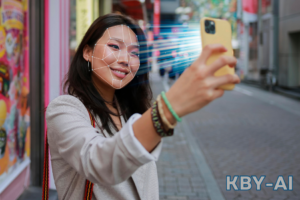The main purpose of face liveness detection technology is to judge whether the face in front of the machine is real or fake.
The face presented by other media can be defined as false face, including printed paper photos, display screen of electronic products, silicone mask, 3D human image, etc. At present, the mainstream solutions includes cooperative living detection and non cooperative living detection (silent living detection). Cooperative living detection requires the user to complete the specified action according to the prompt, and then carry out the live verification, while the silent live detection directly performs the live verification.
Since the Fourier spectrum can reflect the difference of true and false faces in frequency domain to a certain extent, we adopt a silent living detection method based on the auxiliary supervision of Fourier spectrum. The model architecture consists of the main classification branch and the auxiliary supervision branch of Fourier spectrum. It checks if a face is real or a fake attempt, like a photo or mask. It boosts security in face recognition by stopping spoofing.
It happens at two levels: sensor (raw camera data) and feature (facial image details). It can join face recognition for a secure user experience.
Why is face liveness detection important?

It is important since it protects our privacy and our face recognition systems. These systems, as you can see, are everywhere, from confirming your identification to allowing you to enter restricted places.
The problem is that they are not failsafe. They are readily duped by dishonest people using images, movies, or masks. Sneaky, yes?
This is where facial liveness detection comes into play. Our liveness detection for face recognition systems’ version of a superhero, it detects false faces and responds, “Nope, not today!”
So, you may have faith that these systems will function properly and keep out imposters. Additionally, it’s all about making your life easier – with fewer confusions and more convenience!
How does face liveness detection works
Face liveness detection figures out if a face image is from a real person or a fake. There are two types: active and passive methods.
Active methods make you do stuff, like blink, smile, or nod. The system checks your actions to confirm you’re real. They’re good because they catch fakes well, but they can be a hassle and might not work if you’re having a bad facial day.
Passive liveness detection methods don’t need you to do anything special. They just look at your face and check for any weird stuff that might mean you’re fake. These are easy for you but not as good at catching fakes. If you want a software development kit then kby-ai.com is the best place.
Challenges and limitations of face liveness detection
Face liveness detection is quite a challenge, and it has its fair share of difficulties. Let’s break down the main issues:
-
Spoofing Attacks:
The biggest problem comes from spoofing attacks. Attackers can use all sorts of tricks like photos, videos, masks, and 3D models. They can even get creative with tactics like print attacks, replay attacks, and 3D mask attacks.
The complexity of these attacks varies, making life tough for face liveness detection methods. For example, print attacks can fool methods that look at texture, while replay attacks can trick those focusing on motion.
Even 3D mask attacks can deceive methods based on shape or depth. So, staying updated and improving algorithms is crucial to fend off new attacks.
-
Environmental Factors:
Then there are environmental factors to deal with. These are things like lighting, background, camera quality, and noise. They can mess with the quality of the biometric sample and affect how well face liveness detection works.
Bad lighting can mess with image color and contrast, a cluttered background can mess with face recognition, low-quality cameras can make images blurry, and noise can distort the image. Being able to handle these different conditions is a must.
- User Experience: Last but not least, there’s user experience to consider. This is all about how users feel when they’re using face liveness detection. A few factors can affect this:
Method Used: Some methods are more intrusive and inconvenient than others. Active methods need user cooperation, which can be a hassle.
Capture Time: Longer capture times can be boring and annoying. They demand more effort from users.
Feedback: Clear and quick feedback is reassuring and helpful. Vague or slow feedback leaves users in the dark.
Applications and use cases of face liveness detection
Face liveness detection has tons of real-world uses. Here are some key ones:
- Confirming Identity: It’s commonly used to make sure someone is who they say they are. Think online sign-ups, logins, and transactions.
- Tightening Access Control: Helps decide who gets in and who doesn’t. Think offices, airports, and your smartphone’s lock screen.
- Securing Payments: This tech is making payments safer. It works online and even at ATMs.
- Aiding Law Enforcement: Cops and border control can use it to catch the bad guys.
Future trends and developments in face liveness detection
Face liveness detection is an attractive subject that is now under rapid development. The following important developments:
- AI and deep learning:
These are advancing facial liveness detecting technology. They let computers to carry out difficult tasks like image analysis and natural language processing or learn from data. AI and deep learning can:
- Extrapolate additional features from facial photos, such as texture, color, and form.
- Examine eye movements, stances, and facial expressions.
- Identify numerous spoofing efforts (using images, movies, masks, and 3D models).
- Get users to react naturally (blinking, grinning, etc.).
- Adapt to various ambient elements including illumination and noise.
- Using more data sources:
- Deep learning and AI enable the use of more data sources, including:
- Multimodal biometrics: By combining various biometric modalities (voice, face, iris, and fingerprint), security is improved.
- Multispectral imaging: Taking pictures at several wavelengths makes it easier to spot fake artifacts.
- 3D face identification
This method offers the following by using 3D face models for recognition:
- Extraction of characteristics with greater accuracy (curvature, surface normal, etc.).
- Adaptability to changes in lighting and facial emotions.
- smooth capture and verification results in an improved user experience.
- Multimodal Biometrics
Using many biometric liveness detection modalities together results in:
- Increased accuracy and security.
- A variety of properties (such as texture, color, motion, etc.) for study.
- Quicker processes and more flexible capturing lead to improved user experience.
- Face liveness identification will become more reliable, precise, and user-friendly as a result of these trends.
What is face recognition with liveness detection API?
Face recognition with liveness detection is a handy tool. It checks if someone’s face is real and not just a photo or mask. Some examples of these tools are:
- IDfy’s Face Liveness API: It ensures the selfie is real and well-captured, even if there are multiple faces.
- Zyla Face Liveness Check API: Similar to IDfy’s, but it gives a score for face liveness.
- Face Liveness Detection SDK for Android: This is an Android SDK for face recognition and 3D liveness detection, great for attendance tracking.
Conclusion
A facial image’s authenticity is checked using face liveness detection. It is an essential security element that, by identifying false faces, prevents identity theft and unlawful access.
It utilizes facial recognition and is used in many different sectors. The user experience, spoofing attacks, and environmental variables are obstacles, nevertheless.Deep learning and 3D face recognition are two developments that are influencing the field’s evolution.



